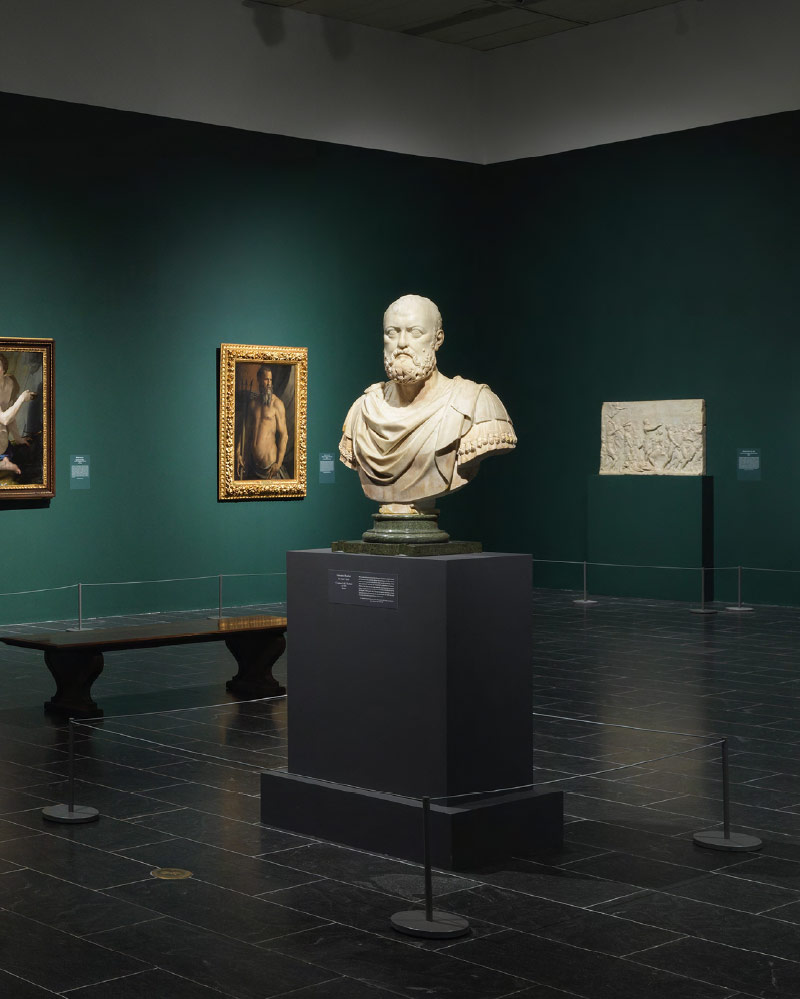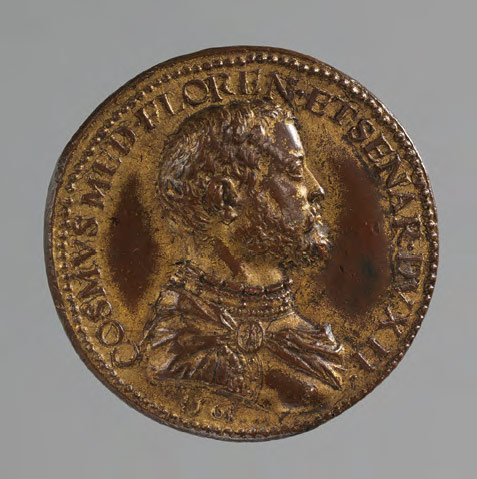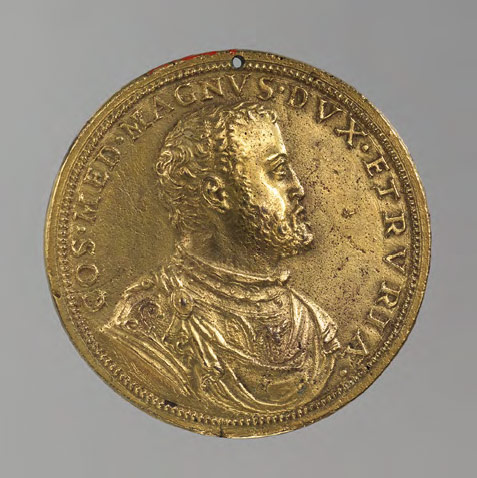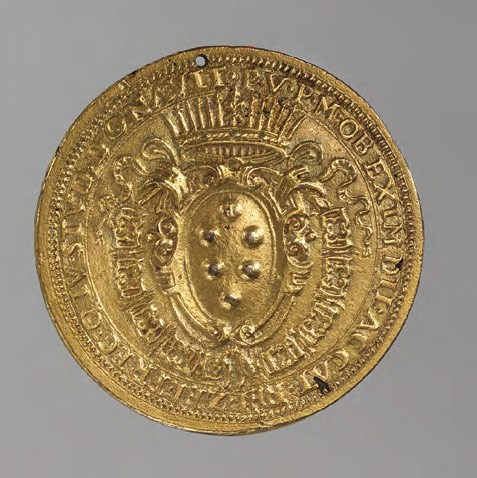The Medici... PORTRAITS! POLITICS?
“It's time you knew: I'm also a contemporary...”
Osip Mandelstam
The exhibition “The Medici: Portraits and Politics, 1512-1570” opened at New York’s Metropolitan Museum on June 26, 2021. A truly impressive range of artefacts drawn from the collections of the Met and from other European, North American and Australian museums, as well as private collections, has been brought together in one exhibition for the first time in the museum’s 150-year history.
More than 90 genuine masterpieces created by the great artists of the Italian Renaissance - from Raphael, Jacopo Pontormo and Rosso Fiorentino to Benvenuto Cellini, Agnolo Bronzino and Francesco Salviati - give the impression of time turned back and allow us an incredible opportunity to indirectly make the acquaintance of various members of the Medici dynasty and the ruling elite of the era of Cosimo I de’ Medici.* The exhibition is indeed “a sort of mirror of contemporary concerns,” as it is characterised by Carlo Falciani, the exhibition’s guest curator and professor of art history at the Accademia di Belle Arti in Florence. The age of Cosimo I de’ Medici is, without doubt, as Falciani emphasises, one of the most glorious periods in the history not only of Italian, but also of European art, so that an encounter with the masterpieces of the epoch is relevant as never before, as the subjects are, in essence, our contemporaries.
* In this regard, it is necessary to note the 2015 exhibition “Florence: Portraits at the Medici Court” at the Musee Jacquemart-Andre in Paris, at which 40 portraits from various European museums were presented.
“The sweep of Italian history and art history in dazzling portraits from the [Medici] dynasty’s final hurrah, on view in a sumptuous exhibition at the Met.”.
The New York Times
“A spectacular exhibition... Organized around fabulous loans from far-flung lenders and a deeply intellectual premise, ‘Medici Portraits’ would be a feat in any climate. In a pandemic, it’s a triumph.”
Wall Street Journal
“The Medici offers a stimulating balance of spectacular art and behind-the-scenes machination that played equal parts in defining one of the most famous periods in history.”
Forbes
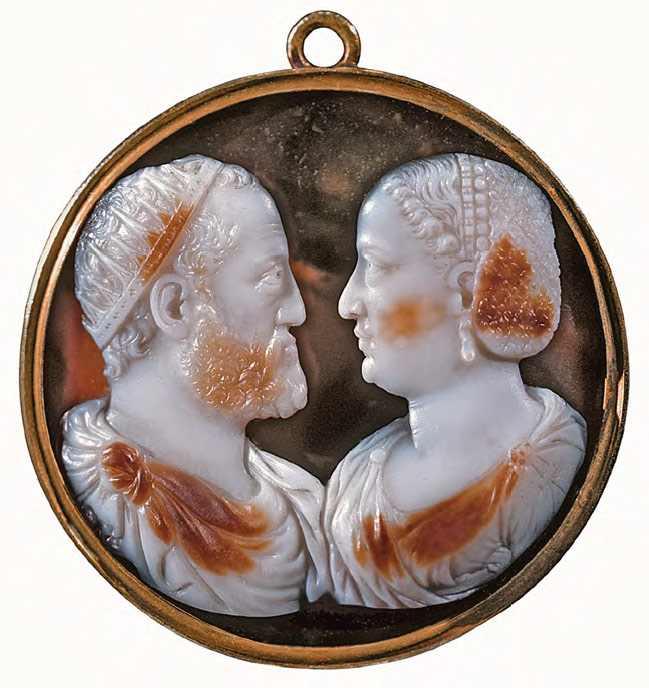
Domenico COMPAGNI, called Domenico de’ Cammei mid 16th century, Italian, Rome – about 1586?
Cameo of Cosimo de’ Medici and Eleonora di Toledo, about 1574
Agate and gold. Diameter 3.7 cm. Museo degli Argenti, Palazzo Pitti, Florence. Image: Gabinetto Fotografico delle Gallerie degli Uffizi, su concessione del Ministero per i Beni e le Attivita Culturali e per il turismo
TO THE MOST ILLUSTRIOUS AND MOST EXCELLENT SIGNOR COSIMO DE’ MEDICI, DUKE OF FLORENCE
“Seeing that your Excellency, following in this the footsteps ofyour most Illustrious ancestors, and incited and urged by your own natural magnanimity, ceases not to favour and to exalt every kind of talent, wheresoever it may be found, and shows particular favour to the arts of design, fondness for their craftsmen, and understanding and delight in their beautiful and rare works, I think that you cannot but take pleasure in this labour which I have undertaken, of writing down the lives, the works, the manners, and the circumstances of all those who, finding the arts already dead, first revived them, then step by step nourished and adorned them, and finally brought them to that height of beauty and majesty whereon they stand at the present day.”
Giorgio Vasari[1]
Your encounter with the exhibition begins with an introduction to Cosimo I de’ Medici, and you may be assured that Cellini’s masterpiece (1545) from the Bargello in Florence leaves an indelible impression. The grand bronze bust, larger than life in scale, has been cleaned of the detritus of centuries for the exhibition, almost coming to life in the process. Indeed, its silvery eyes[2] radiate a truly vital energy.[3] The key figure in Florence’s transition from a republic to a duchy, Cosimo I became the Duke of Florence in 1537. He consciously wielded culture as a political weapon, with the aim of transforming the trading city into the capital of a dynastic Medici state, attracting to his cause the leading intellectuals and artists of the time and supporting grandiose architectural, engineering and artistic undertakings. It is not surprising that it is the Duke who welcomes viewers and invites them to immerse themselves in an atmosphere of emotional and intellectual communion with representatives of the Medici dynasty and their contemporaries. This is an exhibition to which everyone is invited. Some - although not many - come to reacquaint themselves with old friends, others come to meet strangers. Whatever the case, each visitor leaves the exhibition with a feeling of rapture at the great artists whose exquisite mastery is capable of rendering the long-departed living once again.
Examining the portraits through the prism of our contemporary sense of self in tempus nostrum, we can discover clear and, at times, not so clear (although accessible to a practised eye) allegorical elements inserted by the artists, expressed not only and not so much in the attributes of the subjects’ professions and details of their clothing, as in literary references. The greater the painter, that masterly “visagiste,” the more virtuoso the result of his imagination, the more refined the manner in which he creates, with visual mastery, a wealth of details emphasising the status of the subject, his or her education and pursuit of intellectual interests, and his or her readiness to participate directly or indirectly in events of historical or political importance. A portrait can, after all, be read both as a masterly attempt to re-create the true image of the subject (that is, achieve a likeness with reality) and as a demonstration of the mastery of the artist. The subject’s psychological characteristics and private motivations, their hidden ambitions or lack thereof are all elements the artist either hides or reveals, making specific messages obvious, visible or, seemingly, crucial for contemporaries and the future.
It has to be acknowledged that the Medici, setting themselves the aim of establishing a dynastic state, cast their gaze centuries, if not millennia into the future. Humanity will preserve and protect such works of art not because the subject happened to have been a Pope, but because the portrait is from the brush of the great Raphael[4] or, in the case of the tombs of the Dukes Giuliano and Lorenzo, created by the genius of Michelangelo Buonarroti[5].
But we return now to the halls of the Met to allow Keith Christiansen[6] a few words. Opening the exhibition, he said:
“Despite what its title might suggest, the exhibition is not about the Medici and their climb to power, but about the social and intellectual elite who inhabited this transformed state and the politics of culture that Cosimo brilliantly employed to reclaim the great literary, intellectual and artistic figures of Florence’s republican past to exalt a new, absolutist state. At the very centre of this transformation were questions of identity: a communal identity constructed around a common language and a shared cultural and intellectual heritage descended from the city’s republican past. Cosimo founded a state institution - the Accademia Fiorentina - to promote this heritage, which had, at its centre, Dante, who you will recall was himself a victim of political exile.[7] It’s a story worth reflecting about today.”
The first three sections of the exhibition are presented chronologically: “From Republic to Duchy, 1512-1532,” “The Medici and Florence, 1513-1537” and “Cosimo I de’ Medici: Lineage and Dynasty.”
The years 1512 to 1532 represent the period immediately preceding the taking of Florence after a long and dramatic siege by Alessandro de Medici, subsequently elevated to the rank of Duke of Florence. At the time, the works of most Florentine artists were distinguished by a severity of style that reflected the traditional moral values of the Republic and compositional details hinted at the subject’s profession. However, change was in the offing and the style of Florentine artists was evolving, as vividly demonstrated by the wonderful female portrait by Bronzino (“Portrait of a Lady with a Lapdog,” about 1532-1533), brought to the exhibition from the Stadel in Frankfurt.
The exhibition’s next section, “The Medici and Florence, 1513-1537,” is devoted to the members of the Medici dynasty who became the key players in political intrigue as far afield as Rome, where they occupied influential roles in the hierarchy of the Catholic Church. The jewel of this section is Raphael’s wonderful portrait of Lorenzo de’ Medici (1518), from a private collection, and the extremely curious portrait of Allesandro de’ Medici by Jacopo Pontormo (1534-1535), sent to the exhibition by the Philadelphia Museum of Art. In the subsection “The Last Republic and the Siege of Florence, 15271530,” visitors can see a portrait by Pontormo from the Getty Museum (1528-1530), depicting a young halberdier ready to defend the Florentine Republic from the imperial armies. This painting is accompanied, as it has been at previous exhibitions, by authentic examples of 16th-century weapons drawn from the weaponry and armour collection of the Metropolitan Museum.
Cosimo I was 17 years of age when he became the Duke of Florence upon the death of Alessandro, killed by his cousin in 1537. Cosimo moved immediately to consolidate power in his hands and create the conditions necessary for a transformation of the city into the “court of the Medici”. The exhibition’s third section, titled “Cosimo I de’ Medici: Lineage and Dynasty,” recounts how the Duke cultivated his image as heir and guardian of the great traditions of the Medici, striving by any means to strengthen the link between him and his renowned forebears. Depictions of members of the Ducal family were employed to demonstrate the strength and power of the dynasty, as well as to emphasise continuity and convey an impression of high culture and cultivated tastes. The impression left by portraits of Cosimo I is complemented by the truly enchanting portraits of his children by Bronzino from the Uffizi Gallery in Florence (“Portrait of Francesco I de’ Medici”, about 1551) and the Prado Gallery in Madrid (“Portrait of Garcia de’ Medici”, about 1550), as well as by the portrait of his wife, Eleanor of Toledo (about 1539-40, National Gallery Prague). The Museo Nazionale di Palazzo Reale in Pisa has provided not only the portrait of Eleanor of Toledo with her son Francesco (about 1550), but also her red velvet dress.
A refined appreciation of allegory and metaphor often led portrait art of this era to one of the most captivating phenomena in the Western European tradition, when the subject is depicted in the shape of a mythological or biblical character. The allegorical depiction of Cosimo I in the image of Orpheus (1537-1539) from the Philadelphia Art Museum and the portrait of Cosimo’s son Giovanni in the image of John the Baptist (15601561) from the Galleria Borghese in Rome are both vivid examples of this development.
“Dante's creation is, above all, the entrance of the Italian language of his day onto the world stage, its entrance as a totality, as a system."
Osip Mandelstam, “Conversation about Dante”. 1933
The section “Poetics of Portraiture” illustrates how the literary tradition, resting and building upon the works of Dante Alighieri and Francesco Petrarch, enabled the formation of a most attractive standard of portraiture: the subject is painted with a small collection of poetry in hand, representing a replacement of the attributes of their profession with those of their intellectual interests. Two such paintings from the Met’s collection - “Portrait of a Young Man with a Book” (putatively dated to the mid 1530s) by Bronzino, the Medici’s leading court painter, and a portrait of physician Carlo Rimbotti by Salviatti (putatively dated to 1548) - serve as the exhibition’s idiosyncratic centralising impulse.
In this respect, we would be remiss not to refer to the special interest cultivated towards the theme of “poetry - Dante - Petrarch - painting” by Russianspeaking art lovers. Dante’s "The Divine Comedy” in Mikhail Lozinsky’s translation (1936 - 1942) represents the outstanding achievement of the Russian school of translation, with certain of its lines firmly entering the pantheon of Russian culture. The sonnets of Petrarch and “The Divine Comedy” were first translated into Russian as early as the beginning of the 19th century - indeed, the first to translate them was the poet Gavriil Derzhavin (1743-1816).
Returning our attention to the portraits, these volumes of poetry bear witness not only to a love of reading, but also to the patriotism of the subjects, to their belonging to a certain cultural stratum of society, ideological loyalty or heterodoxy.
It is worth paying special attention to Bronzino’s magnificent portrait of the renowned female poet Laura Battiferri (about 1560), which forms part of a relatively small section devoted to the theme “Cosimo I and the Politics of Culture”. There is a book of Petrarch’s sonnets in her hands, open to reveal Sonnet LXIV (64) “Se voi potesti per turbati segni...” (“If you, with signs of your unease...”[8] and CCXL (240) “I’ o pregato Amor, e ‘l ne riprego...” (“I have prayed to Love, and I pray again”)[9]. This portrait from the collection of the Palazzo Vecchio in Florence is paired in the exhibition with the manuscripts of verse that Laura Battiferri[10] exchanged with Bronzino. This should not come as a surprise - the artist was not only renowned as a painter, but also as a poet. Bronzino wrote around 230 sonnets and canzoni, some of which have been translated into Russian.
The commemoration of a great era traditionally culminates in the casting of medals and so the exhibition includes a series of medals marking the transformation undergone by Florence in the time of Cosimo I. His tireless efforts to strengthen the status of Florence as the epicentre of the fine arts and capital of the Italian Renaissance found recognition in Giorgio Vasari’s famous opus “Lives of the Most Eminent Painters, Sculptors and Architects”, which confirmed Florence’s primacy in the history of Renaissance art. Cosimo’s far-sighted soft-power campaign (as we would term it today) defined for the ages the reputation of Florence and the Medici dynasty even after his own death in 1574.
Medallist: DOMENICO POGGINI, 1520, Florence – 1590, Rome
Cosimo I de’ Medici (1519–1574), Duke of Florence, 1537; Grand Duke of Tuscany, 1561
Gilt bronze. Diameter 38 mm. The Metropolitan Museum of Art, New York. Obverse, Reverse
Medallist: Domeniko di POLO
Cosimo I of Tuscany. 16th century
Gilt metal. Diameter 42 mm. The Metropolitan Museum of Art, New York. Obverse, Reverse
The sixth and final section of the exhibition (“Florence and Rome: Bronzino and Salviati”) affords visitors the opportunity of comparing the two Mannerists competing at the court of Cosimo I: Agnolo Bronzino and Francesco Salviati. One can juxtapose the individual features of each artist’s work and discover the depth of the influence each had on the artistic achievements of the other. On the or ders of Cosimo I, they both worked on the decoration of the Pallazzo Vecchio, a municipal building in the republican period and a ducal palace in the time of Cosimo.
Be that as it may, Cosimo’s clear preference was for Bronzino’s painterly style, which set the universally acknowledged standard for state portraits of the ruling elite. The exhibition is crowned by two wonderful portraits of one of the chief opponents of Cosimo’s rule, the Florentine banker Bindo Altoviti: a bronze bust by Cellini (1549-1550) from the collection of the Isabella Stewart Gardner Museum in Boston and a portrait by Salviati (1545, private collection).
Such is the dialogue between two different views of artistic expression that closes this exhibition, which is as grandiose in its conception as it is in its execution. We are grateful to the great masters of the past for this enlightening and absorbing trip through time and for the opportunity, in the words of Pavel Muratov[11], to acquaint ourselves with Florence, “the cradle and coffin of the Renaissance.”
- Vasari, G. Lives of the Most Eminent Painters, Sculptors and Architects. Translated by Gaston du C. De Vere.
- A similar approach was employed by ancient masters in bronze sculpture.
- The exhibition also features the marble version from the Fine Arts Museums of San Francisco. This represents the first occasion on which the two sculptures have been exhibited together.
- Raphael Sanzio, Portrait of Pope Leo X with two Cardinals (1517-1519, Uffizi Gallery, Florence). Leo X (Giovanni Medici) was the son of Lorenzo the Magnificent.
- The pairs of figures Day and Night and Morning and Evening are allegories for the Medici motto “Semper” (“Always”), that is, from morning to evening, day and night. One of nearly 200 of Michelangelo’s surviving poems is dedicated to the tragic image of the night: “Precious is sleep, better to be of stone,/while the oppression and the shame still last;/not seeing and not hearing, I am blest;/so do not wake me, hush! Keep your voice down.”
- Honorary Chairman of the Department of European Paintings (the John Pope-Hennessy Fund).
- “He did not return, even after his death, to That ancient city he was rooted in. Going away, he did not pause for breath Nor look back. My song is for him. Torches, night, a last embrace, Fate, a wild howl, at his threshold. Out of hell he sent her his curse And in heaven could not forget her. But never in a penitential shirt did He walk with a lighted candle and barefoot Through beloved Florence he could not betray, Perfidious, base, and self-deserted” Anna Akhmatova, Dante. 1936
- “If you, with signs of your unease, Lowering your eyes, bowing your head, Or being more ready than anyone to flee, Turning your face from honest worthy prayers, Or by some other ingenuity, seek escape. So from my heart, from which Love grafts More branches of that first laurel, I’d agree There was just cause for your disdain: For a noble plant in arid soil Is embarrassed by it, so naturally Delights in being moved somewhere else: And though your destiny prevents you Being elsewhere, you can at least provide That you’re not always somewhere you hate.” (Translation by A. S. Kline)
- “I have prayed to Love, and I pray again That he’ll make you pardon me, my sweet hurt, My bitter joy, if in perfect loyalty I stray at all from the straight way. I cannot deny, lady, and don’t deny That reason, that restrains all good souls, Is overcome by passion: so he leads me At times to places where I unwillingly follow. You, with that heart that heaven illumines With such clear wit, and such noble virtue, As ever rained down from a fortunate star, Should say, with pity and without disdain: ‘What else can he do? My looks consume him: Why does he long so, why am I so beautiful?’” (Translation by A. S. Kline)
- Laura Battiferri’s response in verse to her portrait by Agnolo Bronzino: “Just as your shepherdess, in her shining and vague face Openly shows you, bright Crisero*, All that her chaste and sincere heart desires, Be you then content and satisfied. As my own new image, lofty work of your skilled Hand, Discloses my every affection and every thought, However my heart would Prefer to keep them hidden.” (Translation by Victoria Kirkham) * This is how Agnolo was known to his friends. Bronzino had fair hair, which is why he was called Crisero, meaning gold or golden. The name Bronzino itself, in fact, is also a nickname based on the colour of his hair. His real name was Agnolo di Cosimo di Mariano.
- Pavel Pavlovich Muratov (18811950) was a Russian writer, art critic, translator and publisher. His book of essays Images of Italy has been published in several editions.
Bronze. 110 × 98 cm
Museo Nazionale del Bargello, Florence
Photo: Antonio Quattrone
Oil on panel, 93.7 × 76.4 cm
Philadelphia Museum of Art
Image: Courtesy Philadelphia Museum of Art
Oil on panel. 101.3 × 81.9 cm
Philadelphia Museum of Art; John G. Johnson Collection
Image: Courtesy Philadelphia Museum of Art
Oil on panel. 89.8 × 70.5 cm
Staedel Museum, Frankfurt am Main
Image: © Staedel Museum, Frankfurt am Main
Oil on canvas. 97.2 × 79.4 cm
Private Collection
Image: Private Collection / Bridgeman Images
Oil on panel. 48 × 38 cm.
Museo Nacional del Prado, Madrid
Image: © Photographic Archive, Museo Nacional del Prado, Madrid
Oil on panel. 57.5 × 43 cm
Galleria degli Uffizi, Florence
Oil on panel. 120 × 92 cm.
Galleria Borghese, Rome
Velvet, Height 150 cm
Museo Nazionale di Palazzo Reale, Pisa
Photo: Arrigo Coppitz, from the archive of the Regional Directorate of Museums of Tuscany
Oil on panel. 116 × 95 cm. Museo Nazionale di Palazzo Reale, Pisa
Image: © Haltadefinizione Image Bank by permission of the Ministry of Cultural Activities and Heritage — Polo Museale della Toscana
Oil on wood. 95.6 × 74.9 cm
The Metropolitan Museum of Art, New York, H.O. Havemeyer Collection
Oil on wood. 52.5 × 41.5 cm
The Metropolitan Museum of Art, New York
Oil, possibly mixed with tempera, on canvas, transferred from panel. 95.3 × 73 cm
The J. Paul Getty Museum, Los Angeles. Image: courtesy of the Getty’s Open Content Program
Oil on wood. 116.5 × 85.7 cm.
The Frick Collection
Oil on panel. 87.5 × 70 cm
Museo di Palazzo Vecchio, Florence
Image: © Musei Civici Fiorentini — Museo di Palazzo Vecchio
Oil on panel. 109 × 84 cm
Galleria Sabauda, Turin
Image: Scala / Art Resource, NY
Oil on wood, likely poplar. 106.7 × 82.5 cm
National Gallery of Canada, Ottawa
Image: NGC
Oil on marble. 88 × 72 cm.
Private Collection
Photo: © Bruce M. White, 2020








